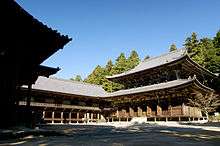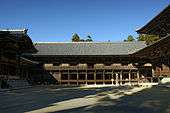Engyō-ji
The Shoshazan Engyō-ji (書写山圓教寺 or less commonly 書寫山圓教寺) is a temple of the Tendai sect in Himeji, Hyōgo, Japan. It was founded by Shoku Shonin in 966.
| Shoshazan Engyō-ji | |
|---|---|
 One of the main buildings in the Shoshazan Engyoji Temple complex. | |
| Religion | |
| Affiliation | Tendai |
| Deity | Nyoirin Kannon (Cintamāṇicakra) |
| Location | |
| Location | 2968, Shosha, Himeji, Hyogo 671-2201 |
| Country | Japan |
| Architecture | |
| Founder | Shoku |
| Completed | 966 |
| Website | |
| http://www.shosha.or.jp/ | |
The complex of buildings is at the top of Mt Shosha approximately 25 minutes by bus from Himeji Station. The mountain summit can be reached by either a one-mile hiking trail or Mt. Shosha Ropeway, and is often visited by pilgrims. Scenes from The Last Samurai were filmed there.
Engyō-ji is temple No. 27 in the Kansai Kannon Pilgrimage, following Ichijō-ji and preceding Nariai-ji.
Building list
- Daikōdō - Important Cultural Property of Japan. It was rebuilt in Muromachi period.
- Jōgyōdō - Important Cultural Property of Japan. It was rebuilt in Muromachi period.
- Jikidō - Important Cultural Property of Japan. It was rebuilt in Muromachi period.
- Shōrō - Important Cultural Property of Japan. It was rebuilt in Kamakura period.
- Kongodō - Important Cultural Property of Japan. It was rebuilt in Muromachi period.
- Gohōdō - Important Cultural Property of Japan. It was rebuilt in 1559.
- Gohōdō haiden - It was rebuilt in 1589.
- Maniden - It was rebuilt in 1933.
- Yakushidō
- Daikokudō
- Hokkedō
- Kaizandō - Important Cultural Property of Japan. It was rebuilt in Edo period.
- Fudōdō
- Gyōjadō
- Monjudō
- Bentendō
- Juryōin - Important Cultural Property of Japan.
- Jumyōin - Kyakuden, Kuri and Karamon is Important Cultural Property of Japan.
- Myōkōin
- Zuikōin
- Sengakuin
- Jujiin
 Maniden
Maniden Jikidō
Jikidō Shōrō
Shōrō Jyōgyōdō
Jyōgyōdō
 Mount Shosha Ropeway
Mount Shosha Ropeway
gollark: If it's in the terms, you can do it, probably.
gollark: Why not?
gollark: I don't see how it'd be an issue if the server and client only interacted over the actual Krist network.
gollark: Krist has undergone massive deflation.
gollark: Wrong.
See also
- For an explanation of terms concerning Japanese Buddhism, Japanese Buddhist art, and Japanese Buddhist temple architecture, see the Glossary of Japanese Buddhism.
External links
- Mt. Shosha - Engyoji (Japanese)
- Official Himeji tourism website in English
- Hyogo Tourism - Engyoji
| Wikimedia Commons has media related to Engyō-ji. |
This article is issued from Wikipedia. The text is licensed under Creative Commons - Attribution - Sharealike. Additional terms may apply for the media files.